Frascos de cultura de célulassão usados principalmente para cultura de células de pequena e média escala, então que tipo de células podem ser cultivadas em frascos de cultura de células?
Existem muitos tipos de células, que são divididas em células aderentes e células em suspensão de acordo com seus padrões de crescimento. O crescimento de células aderentes deve ter uma superfície de suporte que possa ser fixada, e as células dependem de fatores de fixação secretados por elas mesmas ou fornecidos no meio de cultura. Para crescer e se reproduzir nesta superfície. O crescimento das células em suspensão não depende da superfície do suporte e cresce em suspensão no meio de cultura. Os frascos de cultura de células são geralmente feitos de matérias-primas de poliestireno transparente. As especificações comuns incluem 25cm2, 75cm2, 175cm2 e 225cm2. A superfície inferior do frasco da célula é projetada com uma forma de arco para reduzir os ângulos mortos de contato ao pipetar as células. Pode ser usado tanto para a cultura de células aderentes quanto para a cultura estática de células em suspensão. Os tipos de células aplicáveis são os seguintes:
Células aderentes: células Vero, células HEK 293, células CAR-T, MRC5, células CEF, macrófagos alveolares porcinos, células de mieloma, células DF-1, células ST, células PK15, Marc145 células, etc.
Células em suspensão: células CHO, células de insetos, células BHK21 e células MDCK, etc.
Deve-se notar que se os frascos de cultura de células forem usados para o cultivo de células aderentes, a superfície do O frasco precisa ser especialmente modificado para aumentar sua hidrofilicidade para atender às características de crescimento das células aderentes. Quando usado em cultura de células em suspensão, não é necessário nenhum tratamento especial.
The FAI climbed 5.9 percent year-on-year in the first 11 months of 2018, quickening from the 5.7-percent growth in Jan-Oct, the National Bureau of Statistics (NBS) said Friday in an online statement.
The key indicator of investment, dubbed a major growth driver, hit the bottom in August and has since started to rebound steadily.
In the face of emerging economic challenges home and abroad, China has stepped up efforts to stabilize investment, in particular rolling out measures to motivate private investors and channel funds into infrastructure.
Friday's data showed private investment, accounting for more than 60 percent of the total FAI, expanded by a brisk 8.7 percent.
NBS spokesperson Mao Shengyong said funds into weak economic links registered rapid increases as investment in environmental protection and agriculture jumped 42 percent and 12.5 percent respectively, much faster than the average.
In breakdown, investment in high-tech and equipment manufacturing remained vigorous with 16.1-percent and 11.6-percent increases respectively in the first 11 months. Infrastructure investment gained 3.7 percent, staying flat. Investment in property development rose 9.7 percent, also unchanged.
 English
English



















































